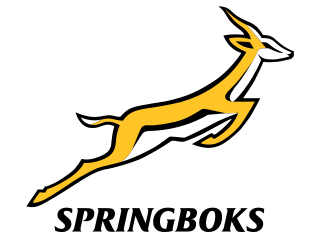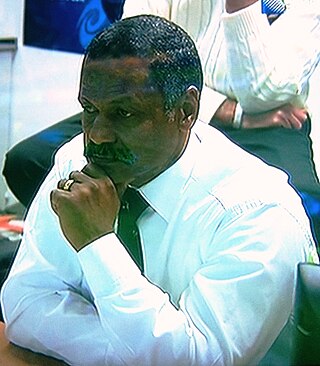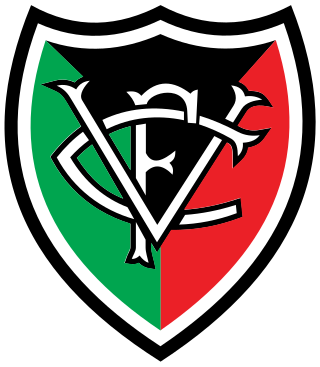Related Research Articles

The South Africa national rugby union team, commonly known as the Springboks, is the country's national team governed by the South African Rugby Union. The Springboks play in green and gold jerseys with white shorts, and their emblem is the Springbok, a native antelope and the national animal of South Africa. The team has represented South African Rugby Union in international rugby union since 30 July 1891, when they played their first test match against a British Isles touring team. Currently, the Springboks are the reigning World Champions, having won the World Cup a record four times. South Africa have won half of the Rugby World Cups they have participated in and are also the second nation to win the World Cup consecutively.

Daniël Hartman Craven was a South African rugby union player (1931–1938), national coach, national and international rugby administrator, academic, and author. Popularly known as Danie, Doc, or Mr Rugby, Craven's appointment from 1949 to 1956 as coach of the Springboks signalled "one of the most successful spells in South African rugby history" during which the national team won 74% of their matches. While as a player Craven is mostly remembered as one of rugby's greatest dive-passing scrumhalves ever, he had also on occasion been selected to play for the Springboks as a centre, fly-half, No.8, and full-back. As the longest-serving President of the South African Rugby Board (1956–93) and chairman of the International Rugby Board, Craven became one of the best-known and most controversial rugby administrators. In 1969, Craven sparked outrage among anti-apartheid activists when he allegedly said, "There will be a black springbok over my dead body". Craven denied saying this and in his later career promoted black and coloured training facilities.

Schalk Willem Petrus Burger Jr. is a South African former professional rugby union player. He played as a flanker for Saracens in the English Premiership and has won 86 caps for South Africa.

John William Smit, OIS, is a South African former professional rugby union player and former chief executive officer of the Sharks. He was the 50th captain of the Springbok rugby union team and led the team to win the 2007 Rugby World Cup. He played most of his senior career as a hooker, but also won 13 caps as a prop, where he had also played for South Africa's under-21 team. He retired from international rugby following the 2011 Rugby World Cup as the most-capped South African player ever, with 111 appearances.

Bryan Gary Habana OIS is a South African former professional rugby union player. Playing mainly as a wing, he is widely considered to be one of the greatest players in the history of the sport. He played for the Golden Lions, the Blue Bulls and Western Province in South Africa, for the Bulls and the Stormers in Super Rugby, and for Toulon in the French Top 14, and won 124 caps for the South Africa national team.
Jan Christian Stewart is a former rugby union centre, who played internationally for Canada and the South Africa Springboks. Stewart earned 17 caps, 14 with Canada and three with South Africa.
Raymond Herman Mordt is a Zimbabwean/South African rugby footballer who represented his country in rugby union before moving to English professional rugby league club, Wigan, with whom he won the Championship during the 1986–87 season. He is the uncle of England Sevens player Nils Mordt.

Paul Johannes Roos was one of the first South African Springbok rugby union captains and led the first South African rugby team to tour overseas – to Britain in 1906. Roos was born near the South African town of Stellenbosch on 30 October 1880 and completed his education there.
Paul Roos Gymnasium is a leading public dual medium high school for boys in the town of Stellenbosch in the Western Cape province of South Africa, which opened on 1 March 1866 as Stellenbosch Gymnasium. Described as South Africa’s Eton College by novelist Wilbur Smith, it is the 12th oldest school in the country, and its Old Boys have had an important, wide-ranging and notable impact on the history of South Africa.

In rugby union a scrum is a means of restarting play after a minor infringement. It involves up to eight players from each team, known as the pack or forward pack, binding together in three rows and interlocking with the three opposing teams front row. At this point the ball is fed into the gap between the two forward packs and they both compete for the ball to win possession. Teams can be penalised for intentionally causing the scrum to collapse, and for not putting the ball into the scrum correctly. A scrum is most commonly awarded when the ball is knocked forward, or passed forward, or when a ball becomes trapped in a ruck or maul. Because of the physical nature of scrums, injuries can occur, especially in the front row.

Peter de Villiers is a South African professional rugby union coach and former Good Party politician. He was coach of the South Africa national rugby union team from 2008 to 2011, after successes with the South African U19 and U21 squads, and the first-ever non-white to be appointed to the position.

Harold "Paddy" Carolin was a rugby union player who represented South Africa and is credited with conceiving both the 3-4-1 scrum formation and helping choose the name 'Springboks' for the South African national side. Carolin was the second player ever to serve as captain abroad, following Paul Roos.
Izak Stephanus de Villiers "Balie" Swart is a South African former rugby union player. He played as a prop, with the ability to play on either the loosehead or the tighthead side. He earned 16 caps for the South Africa national team between 1993 and 1996.

Villager Football Club was established on 2 June 1876 and claims to be the second oldest rugby club in Cape Town, South Africa. Villager FC were scheduled to play against Stellenbosch Rugby Football Club in the first official match at Newlands Stadium after it opened on 31 May 1890. Many notable South African rugby players began their careers at the club, including Paddy Carolin, vice-captain on the 1906 Springbok tour to Europe, and former 800m track world record holder Marcello Fiasconaro.
Pieter Willem Gabriel Rossouw is a South African former professional rugby player and current coach. Rossouw played wing for Western Province in the Currie Cup and the Stormers in the Super Rugby competition. He played a total of 43 times for the Springboks, making him one of the most capped Springbok wingers after South Africa's readmission to international rugby. He was also one of South Africa's most prolific try-scoring wingers, post-isolation, with only Breyton Paulse(26) and Bryan Habana(53) scoring more tries. He is 7th on the all-time try-scoring list for the Springboks. Rossouw is currently the backline coach of the Bulls in Super rugby and the Blue Bulls in the Currie Cup. He was known as "Slaptjips", apparently because the sight of his running legs was like potato chips slapping together. Pieter is the older brother of Chris Rossouw, who played flyhalf for Western Province and the Free State Cheetahs.
The History of the South Africa national rugby union team dates back to 1891, when the British Lions first toured South Africa where they played against South African representative sides. The South Africa national rugby union team played few international matches during a period of international sanctions due to apartheid. Since the end of apartheid in 1994, South Africa has once again fully participated in international rugby.
Johannes Joubert (Ballie) Wahl was a scrum-half rugby union player for South Africa's Springboks.
Schalk Willem Petrus Burger Snr. is a South African former rugby union player.
Pieter Kuyper Albertyn , known as "PK" or "Pierre", was a South African rugby union player and 15th captain of the South Africa national rugby union team.
References
- ↑ Verster, Francois. "Markötter spring daaruit sy graf... [ Markötter then jumps out of his grave...] ..." bolanderproperty.co.za. Bolander Lifestyle & Property. Archived from the original on 2 January 2014. Retrieved 1 January 2014.
- 1 2 3 4 5 6 7 8 "Class of 2009: Candidates for induction into the IRB Hall of Fame – August Frederick 'Oubaas' Markötter (South Africa) (1878–1957)". IRB.com. IRB Hall of Fame. Archived from the original on 24 December 2013. Retrieved 1 January 2014.
- 1 2 3 4 5 6 7 "Die straatname van die Pretoriase voorstad Danville" (PDF). Pretoriana – Magazine of the Old Pretoria Society. 58: 13–14. December 1968. Retrieved 1 January 2014.
- ↑ "Vandag in die Geskiedenis". Die Burger. 10 June 2006. Archived from the original on 2 January 2014. Retrieved 1 January 2014.
- ↑ Volschenk, Johan (19 December 1999). "Curriebeker-glorie is 'n wals [Currie Cup glory is a waltz]". Rapport. Archived from the original on 2 January 2014. Retrieved 1 January 2014.
- ↑ "Past tour results, 1902-3 – Western Province Country 13–7 British & Irish Lions". lionsrugby.com. British & Irish Lions. Archived from the original on 2 January 2014. Retrieved 1 January 2014.
- ↑ Carolin, Harold William (1990). Lappe Laubscher; Gideon Nieman (eds.). The Carolin papers: a diary of the 1906/07 Springbok tour. Pretoria: Rugbyana. pp. 34–35. ISBN 9780620145015.
- ↑ Harris, Tim (2009). Players: 250 Men, Women and Animals Who Created Modern Sport. Random House. ISBN 9780224082778.